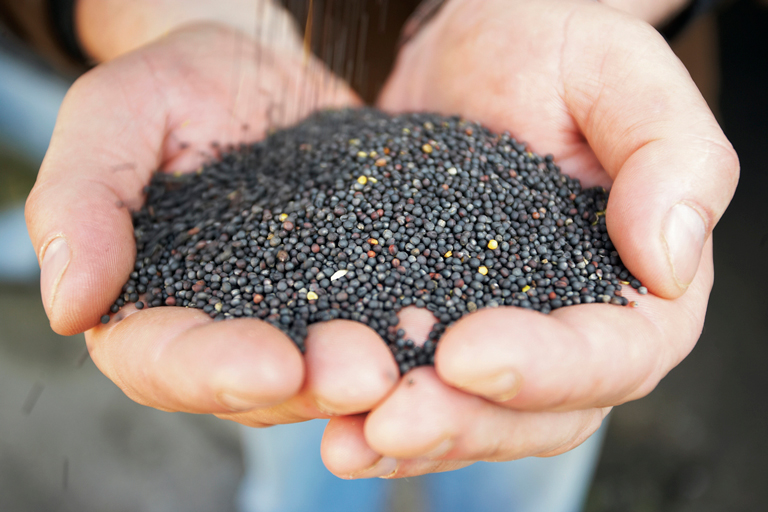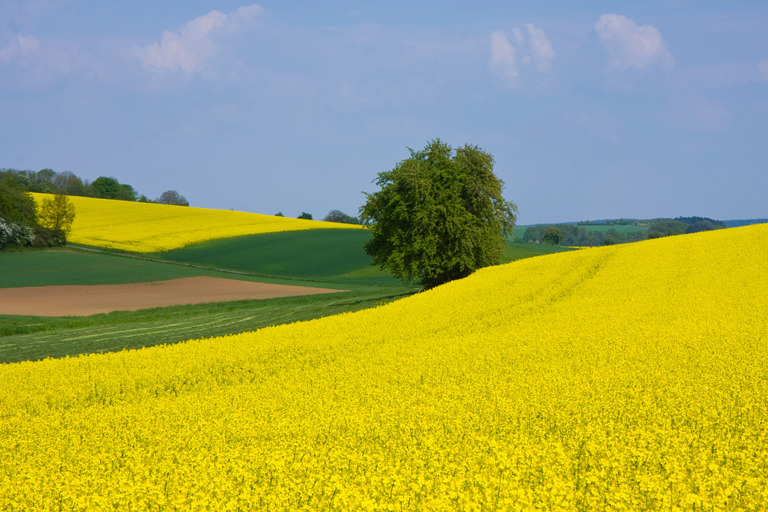
Who benefits from IP rights in agricultural innovation?
By Catherine Jewell, Communications Division, WIPO
In a finite world with an ever-expanding population, agricultural innovation is vital in order to increase productivity and secure the global food supply. But agricultural research and development (R&D) is a risky and costly business.
In the past, agricultural R&D was largely publicly funded but today, increasingly the private sector is picking up the tab for global crop R&D, especially in the area of agricultural biotechnology. The industry’s top ten companies invest some EUR1.69 billion a year – 7.5 percent of sales revenue – on new product development, according to a recent report commissioned by CropLife International and EuropaBio. In this context, intellectual property (IP) rights play a key role in enabling companies to attract investors and generate the returns necessary to recoup development costs and invest in further R&D.

In some quarters, however, there are concerns that IP rights in agricultural technology are pushing up prices and enabling agricultural innovators to generate huge profits at the expense of farmers and the public. How well founded are such concerns? Would the innovations have ever existed without the incentives provided by the IP system?
The study by Steward Redqueen on behalf of CropLife International and EuropaBio explores these questions and takes a closer look at the balancing act that underpins the IP system, in particular the trade-off between the need to offer incentives to invest in new innovation so that new and improved innovations are available down the line (future benefits) and the need to ensure public access to the benefits of existing innovations (present benefits).
The researchers established a framework to evaluate the use of IP rights and tested it using the case of Ogura hybrid oilseed rape technology. The study explores the different socio-economic outcomes flowing from three different IP (patent) licensing scenarios: non-exclusive use of IP rights, exclusive IP use and no IP rights. It examines the different ways in which each scenario would influence incentives for innovation as well as consumer benefits once a product enters the market.
The case of Ogura
Developed by the French National Institute for Agricultural Research (INRA) in the mid-1990s, Ogura is non-biotech method for producing high-yielding hybrids of oilseed rape . Long used as a valuable “break crop” to improve soil quality for cereals such as wheat and barley, it also a source of high-quality vegetable oil and animal feed – its tiny black seeds are 45 percent oil and 55 percent high protein animal fodder. Oilseed rape is also used for production of biodiesel and industrial lubricants. In sum, it is a versatile and high-value crop.
The study shows that IP rights play a critical role in enabling innovation in the agricultural sector. “IP rights are essential to enable innovation by providing innovators with the ability to recoup investments and fund new R&D,” says Willem Ruster, co-author of the report. “Innovative crops have transformed farming and are driving long-term productivity and sustainability in agriculture. Hybrid seeds have made and continue to make a major contribution to agricultural productivity increases, adding an estimated EUR75 billion to global farm incomes.”
Crop innovation involves five stages: discovery, proof of concept, early development, advanced development and pre-launch. “It can take between 10 and 15 years to develop commercially viable seeds, so there needs to be some IP protection to provide an incentive for the innovator and to make it possible to keep free riders at bay,” observes Mr. Ruster.
Having done work to prove the concept of Ogura, INRA recognized it was still five to ten years away from producing commercially viable seeds. “INRA knew its capabilities and understood that it was not the right party to develop Ogura commercially so it decided to acquire a bundle of patents over Ogura technology and to license it out to seed companies for further development.” Mr. Ruster says.
INRA’s non-exclusive licenses pay off
INRA decided to make its Ogura hybrid seed technology available to different seed producers through non-exclusive patent licenses. “Licensing is a key means of generating a return on investment. It also creates a legal framework for making technology available to a wider group of researchers in both public and private laboratories who may contribute to its further development,” explains Mr. Ruster. In the case of Ogura, both parties stood to benefit. As the licensor, INRA was able to recoup its development costs, which amounted to over EUR5 million, while staying involved in its further development. As licensees, the seed companies were able to avoid the costs associated with developing the technology from scratch by taking a license from INRA.
Under INRA’s patent license agreement, a five percent royalty was payable on revenue generated up to 2011, and one percent up to 2016. INRA favored this approach over a single upfront license fee because it made it possible to encourage the levels of investment needed to advance the seeds’ development. The approach paid off. Up to 2011, INRA generated EUR50 million in royalties from its Ogura technology, making it possible to recoup development costs and also reduce its reliance on government subsidies.

The first hybrid Ogura seeds were commercialized in 2000. They boosted yields by up to ten percent, and proved popular among farmers. By 2012, Ogura hybrids had captured 83 percent of the oilseed rape seed market in France, the largest oilseed rape producer in Europe, accounting for around nine percent of global oilseed rape production. “The fact that a lot of different seed companies were working on the technology in France, which has a lot of climatic variations, was very helpful in bringing different kinds of seeds to the market. That really helped the technology’s diffusion,” Mr. Ruster says.
However, despite favorable market conditions – rising crop prices and broad uptake of the technology – it still took INRA at least 15 years of licensing to recover its R&D costs and break even. “While it looks like INRA benefitted handsomely from its Ogura technology, we should remember that this income also has to cover the R&D costs of all the technologies that did not make it through the pipeline as well as future R&D projects. For every success, like Ogura, 12 equally costly projects could fail,” Mr. Ruster notes.
Sizeable consumer benefits
The study reveals that over its full patent life, Ogura generated an estimated EUR1.2 billion, of which around 80 percent, some EUR1 billion, went to farmers, downstream processors and consumers. The remaining 20 percent went to those involved in developing the seeds and getting them to market. From 2000 to 2012, the study estimates that the total benefit to farmers relating to Ogura amounted to EUR471 million.
The Ogura case paints a rosy picture of the economic benefits that can flow from the granting of non-exclusive patent licenses, but how might things look if INRA had adopted a different strategy? What might have been the outcome if it had adopted an exclusive licensing approach, or if it had decided to disregard the IPR system all together?
Exclusive patent licensing: expected impacts
The study suggests that an exclusive patent licensing approach – where there is only one party serving the market – would offer producers a stronger incentive and grant them more market power. In the short term, such an approach may result in a lower uptake of the technology by farmers and as a consequence reduce immediate benefits to them and consumers. “We would expect slightly higher prices, so fewer farmers would be likely to be willing to buy the seeds, Mr. Ruster explains.
However, in the longer term, such an approach could encourage innovation because the higher prices charged by licensees could be expected to prompt competitors to develop their own hybrid oilseed rape technology. In such a case, “an exclusive patent licensing approach would act as a stronger magnet for private-sector investment and increase the probability of innovation taking place,” notes Mr. Ruster. Farmers and consumers would also be expected to benefit from having a broader range of improved technologies to choose from.
Greater market power, however, does not necessarily mean producers have a free hand in setting prices or influencing adoption rates within the agricultural sector. “If a producer like INRA, seed companies or distributors sets seed prices too high, uptake will be much smaller because farmers will be unwilling to switch to the new hybrids and so revenues will drop. Similarly, if seed prices are set too low, uptake will be high but margins will suffer,” Mr. Ruster explains. “Our study reveals that in reality, the market power of patent holders is constrained by the presence of alternatives and the heterogeneity of individual farmer preferences.”
No IP rights, no incentives?
So what would be the impact of not using IP rights at all? The study suggests that while benefits to farmers, consumers and other downstream users would increase, and prices might be lower due to greater competition, the incentive for producers to innovate would be all but eliminated. “In this scenario we see that a decision not to use IP rights also has a cost because such an approach diminishes the incentive to innovate. The more chance an innovator has of recouping his investment and of making a profit to reinvest in new innovations, the stronger the incentive to innovate and for future innovations to occur,” says Mr. Ruster.
With respect to the Ogura case, then, INRA’s non-exclusive patent licensing approach seems to have succeeded in balancing the trade-off between present and future benefits. The study offers concrete evidence of the way in which patents can enable agricultural innovation and the far-reaching socio-economic and environmental benefits (see box) that can flow from it.
While Mr. Ruster notes that in the agricultural context “optimal IPR use depends on the technology itself as well as on market conditions,” the Ogura case study offers an interesting framework for evaluating the impact of different IPR regimes, their underlying logic and the balancing act facing policymakers seeking to enhance food security around the world. Ultimately, the choice of IP strategy depends on the intended goal and is a question of short-term versus long-term benefits, market conditions, and the need to manage the risks associated with research and development.
Broader benefits of Ogura technology
Beyond the direct economic benefits of Ogura, the CropLife study reveals benefits in terms of resource efficiency and employment resulting from higher farm incomes.
Savings during Ogura oilseed rape production translate into a reduction of around 66 kg of carbon per tonne and around 300,000 tonnes of CO2 emissions, equivalent to the annual emissions of 150,000 cars.
In 2012 alone, farmers earned an additional EUR123 million from high-yielding oilseed rape, which translated into almost 1,200 new jobs.
The WIPO Magazine is intended to help broaden public understanding of intellectual property and of WIPO’s work, and is not an official document of WIPO. The designations employed and the presentation of material throughout this publication do not imply the expression of any opinion whatsoever on the part of WIPO concerning the legal status of any country, territory or area or of its authorities, or concerning the delimitation of its frontiers or boundaries. This publication is not intended to reflect the views of the Member States or the WIPO Secretariat. The mention of specific companies or products of manufacturers does not imply that they are endorsed or recommended by WIPO in preference to others of a similar nature that are not mentioned.